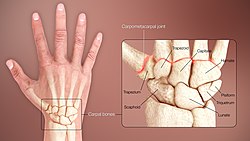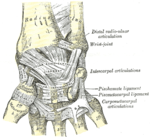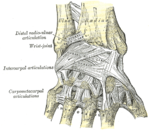How Many Bones Make Up The Wrist
| Wrist | |
|---|---|
 A man showing the wrist in the eye. | |
 The carpal bones, sometimes included in the definition of the wrist. | |
| Details | |
| Identifiers | |
| Latin | articulatio radiocarpalis |
| MeSH | D014953 |
| TA98 | A01.1.00.026 |
| TA2 | 147 |
| FMA | 24922 |
| Anatomical terminology [edit on Wikidata] | |
In human beefcake, the wrist is variously defined as (1) the carpus or carpal bones, the complex of 8 bones forming the proximal skeletal segment of the hand;[one] [2] (2) the wrist joint or radiocarpal joint, the joint between the radius and the carpus[2] and; (iii) the anatomical region surrounding the carpus including the distal parts of the bones of the forearm and the proximal parts of the metacarpus or v metacarpal bones and the series of joints between these bones, thus referred to equally wrist joints.[three] [4] This region too includes the carpal tunnel, the anatomical snuff box, bracelet lines, the flexor retinaculum, and the extensor retinaculum.
As a consequence of these diverse definitions, fractures to the carpal bones are referred to equally carpal fractures, while fractures such equally distal radius fracture are oft considered fractures to the wrist.
Construction [edit]




Ligaments of wrist. Posterior and anterior views
The distal radioulnar joint is a pin joint located between the bones of the forearm, the radius and ulna. Formed past the head of the ulna and the ulnar notch of the radius, this joint is separated from the radiocarpal joint by an articular disk lying betwixt the radius and the styloid process of the ulna. The capsule of the articulation is lax and extends from the inferior sacciform recess to the ulnar shaft. Together with the proximal radioulnar joint, the distal radioulnar joint permits pronation and supination.[five]
The radiocarpal joint or wrist articulation is an ellipsoid joint formed by the radius and the articular disc proximally and the proximal row of carpal bones distally. The carpal basic on the ulnar side simply make intermittent contact with the proximal side — the triquetrum but makes contact during ulnar abduction. The capsule, lax and un-branched, is sparse on the dorsal side and can contain synovial folds. The capsule is continuous with the midcarpal joint and strengthened by numerous ligaments, including the palmar and dorsal radiocarpal ligaments, and the ulnar and radial collateral ligaments. [half-dozen]
The parts forming the radiocarpal joint are the lower terminate of the radius and under surface of the articular disk above; and the scaphoid, lunate, and triquetral bones beneath. The articular surface of the radius and the undersurface of the articular disk form together with a transversely elliptical concave surface, the receiving cavity. The superior articular surfaces of the scaphoid, lunate, and triquetrum form a smooth convex surface, the condyle, which is received into the concavity.[7]
Carpal bones of the hand:
- Proximal: A=Scaphoid, B=Lunate, C=Triquetrum, D=Pisiform
- Distal: East=Trapezium, F=Trapezoid, G=Capitate, H=Hamate
In the hand proper a full of xiii bones form part of the wrist: eight carpal basic—scaphoid, lunate, triquetral, pisiform, trapezium, trapezoid, capitate, and hamate— and v metacarpal bones—the first, second, third, fourth, and 5th metacarpal bones.[8]
The midcarpal joint is the S-shaped joint space separating the proximal and distal rows of carpal basic. The intercarpal joints, betwixt the bones of each row, are strengthened by the radiate carpal and pisohamate ligaments and the palmar, interosseous, and dorsal intercarpal ligaments. Some degree of mobility is possible between the bones of the proximal row while the bones of the distal row are continued to each other and to the metacarpal basic —at the carpometacarpal joints— by strong ligaments —the pisometacarpal and palmar and dorsal carpometacarpal ligament— that makes a functional entity of these basic. Additionally, the joints betwixt the bases of the metacarpal bones —the intermetacarpal articulations— are strengthened by dorsal, interosseous, and palmar intermetacarpal ligaments.[6]
The earliest carpal bones to ossify are capitate bone and hamate bone in the first six months of an babe life.[9]
Articulations [edit]
The radiocarpal, intercarpal, midcarpal, carpometacarpal, and intermetacarpal joints oftentimes intercommunicate through a common synovial cavity. [10]
Articular Surfaces [edit]
It has two articular surfaces named, proximal and distal articular surfaces respectively. The proximal articular surface is made upward of the lower end of the radius and a triangular articular disc of the junior radio-ulnar joint. On the other paw, the distal articular surface is made up of proximal surfaces of the scaphoid, triquetral and lunate bones.[eleven]

Micro-radiography of 8 weeks man embryo paw
Function [edit]
Movement [edit]
The extrinsic paw muscles are located in the forearm where their bellies form the proximal fleshy roundness. When contracted, virtually of the tendons of these muscles are prevented from standing up similar taut bowstrings around the wrist by passing under the flexor retinaculum on the palmar side and the extensor retinaculum on the dorsal side. On the palmar side the carpal basic form the carpal tunnel,[12] through which some of the flexor tendons pass in tendon sheaths that enable them to slide dorsum and forth through the narrow passageway (come across carpal tunnel syndrome).[thirteen]
Starting from the mid-position of the hand, the movements permitted in the wrist proper are (muscles in order of importance):[fourteen] [xv]
- Marginal movements: radial difference (abduction, movement towards the thumb) and ulnar difference (adduction, movement towards the pinkie). These movements take place nigh a dorsopalmar axis (back to front) at the radiocarpal and midcarpal joints passing through the capitate bone.
- Radial abduction (up to twenty°):[16] extensor carpi radialis longus, abductor pollicis longus, extensor pollicis longus, flexor carpi radialis, flexor pollicis longus
- Ulnar adduction (upwardly to 30°):[xvi] extensor carpi ulnaris, flexor carpi ulnaris, extensor digitorum, extensor digiti minimi
- Movements in the aeroplane of the hand: flexion (palmar flexion, tilting towards the palm) and extension (dorsiflexion, tilting towards the back of the manus). These movements take identify through a transverse axis passing through the capitate os. Palmar flexion is the about powerful of these movements because the flexors, especially the finger flexors, are considerably stronger than the extensors.
- Extension (up to lx°):[16] extensor digitorum, extensor carpi radialis longus, extensor carpi radialis brevis, extensor indicis, extensor pollicis longus, extensor digiti minimi, extensor carpi ulnaris
- Palmar flexion (up to 70°):[sixteen] flexor digitorum superficialis, flexor digitorum profundus, flexor carpi ulnaris, flexor pollicis longus, flexor carpi radialis, abductor pollicis longus
- Intermediate or combined movements
However, movements at the wrist tin not be properly described without including movements in the distal radioulnar joint in which the rotary actions of supination and pronation occur and this articulation is therefore normally regarded as part of the wrist.[17]
Clinical significance [edit]

Wrist pain has a number of causes, including carpal tunnel syndrome,[xvi] ganglion cyst,[xix] tendinitis,[xx] and osteoarthritis. Tests such as Phalen's exam involve palmarflexion at the wrist.
The mitt may deviate at the wrist in some weather, such as rheumatoid arthritis.
Ossification of the bones effectually the wrist is one indicator used in taking a bone age.
A wrist fracture unremarkably means a fracture of the distal radius.
History [edit]
Etymology [edit]
The English word "wrist" is etymologically derived from the ancient German word wristiz from which are derived modern German language rist ("instep", "wrist") and mod Swedish vrist ("instep", "ankle"). The base writh- and its variants are associated with Erstwhile English words "wreath", "wrest", and "writhe". The wr- sound of this base seems originally to have been symbolic of the action of twisting.[21]
Come across also [edit]
- Brunelli procedure, related to instability in the wrist, caused past a torn scapholunate ligament.
- Knuckle-walking, a kind of quadrupedal locomotion involving wrist bone specialization
- Wristlocks utilise move extremes of the wrist for martial applications.
- Glossary of bowling § Wrist, a measure out of wrist position in bowling brawl deliveries
Additional images [edit]
-

Wrist joint. Deep dissection. Posterior view.
-

Wrist joint. Deep dissection. Posterior view.
-
Wrist joint. Deep dissection.Inductive, palmar, view.
-
Wrist joint. Deep autopsy.Anterior, palmar, view.
References [edit]
- ^ Behnke 2006, p. 76 "The wrist contains viii bones, roughly aligned in two rows, known equally the carpal bones."
- ^ a b Moore KL, Agur AM (2006). Essential clinical anatomy. Lippincott Williams & Wilkins. p. 485. ISBN0-7817-6274-X.
The wrist (carpus), the proximal segment of the hand, is a complex of eight carpal basic. The carpus articulates proximally with the forearm at the wrist joint and distally with the five metacarpals. The joints formed by the carpus include the wrist (the radiocarpal joint), intercarpal, carpometacarpal, and intermetacarpal joints. Augmenting movement at the wrist joint, the rows of carpals glide on each other [...]
- ^ Behnke 2006, p. 77 "With the large number of bones composing the wrist (ulna, radius, eight carpas, and v metacarpals), it makes sense that there are many, many joints that make upward the structure known as the wrist."
- ^ Baratz Thou, Watson AD, Imbriglia JE (1999). Orthopaedic surgery: the essentials. Thieme. p. 391. ISBN0-86577-779-ix.
The wrist joint is equanimous of not but the radiocarpal and distal radioulnar joints but too the intercarpal articulations.
- ^ Platzer 2004, p. 122
- ^ a b Platzer 2004, p. 130
- ^ "Wrist Articulation". The Lecturio Medical Concept Library . Retrieved 2021-06-23 .
- ^ Platzer 2004, p. 126–129
- ^ Al-Khater KM, Hegazi TM, Al-Thani HF, Al-Muhanna HT, Al-Hamad BW, Alhuraysi SM, et al. (September 2020). "Fourth dimension of appearance of ossification centers in carpal bones. A radiological retrospective study on Saudi children". Saudi Medical Journal. 41 (9): 938–946. doi:10.15537/smj.2020.9.25348. PMC7557557. PMID 32893275.
- ^ Isenberg DA, Maddison P, Woo P (2004). Oxford textbook of rheumatology. Oxford University Press. p. 87. ISBN0-nineteen-850948-0.
- ^ "Wrist Joint". Earth's Lab.
- ^ Rea P (2016-01-01). "Affiliate three - Neck". In Rea P (ed.). Essential Clinically Practical Anatomy of the Peripheral Nervous Organisation in the Head and Cervix. Academic Press. pp. 131–183. doi:10.1016/b978-0-12-803633-iv.00003-x. ISBN978-0-12-803633-4.
- ^ Saladin KS (2003). Anatomy & Physiology: The Unity of Class and Function (tertiary ed.). McGraw-Hill. pp. 361, 365.
- ^ Platzer 2004, p. 132
- ^ Platzer 2004, p. 172
- ^ a b c d e Lalani I, Argoff CE (2008-01-01). "Chapter 10 - History and Physical Examination of the Pain Patient". In Benzon HT, Rathmell JP, Wu CL, Turk DC (eds.). Raj's Applied Direction of Hurting (Quaternary ed.). Philadelphia: Mosby. pp. 177–188. doi:10.1016/B978-032304184-3.50013-3. ISBN978-0-323-04184-3.
- ^ Kingston B (2000). Agreement joints: a applied guide to their construction and part. Nelson Thornes. pp. 126–127. ISBN0-7487-5399-0.
- ^ Döring Ac, Overbeek CL, Teunis T, Becker SJ, Ring D (October 2016). "A Slightly Dorsally Tilted Lunate on MRI can be Considered Normal". The Archives of Bone and Joint Surgery. iv (iv): 348–352. PMC5100451. PMID 27847848.
- ^ Stretanski MF (2020-01-01). "Chapter 32 - Mitt and Wrist Ganglia". In Frontera WR, Silver JK, Rizzo TD (eds.). Essentials of Concrete Medicine and Rehabilitation (Fourth ed.). Philadelphia: Content Repository Only!. pp. 169–173. doi:10.1016/B978-0-323-54947-9.00032-eight. ISBN978-0-323-54947-9.
- ^ Waldman SD (2014-01-01). "Affiliate 58 - Flexor Carpi Radialis Tendinitis". In Waldman SD (ed.). Atlas of Uncommon Pain Syndromes (Third ed.). Philadelphia: W.B. Saunders. pp. 172–174. doi:10.1016/b978-1-4557-0999-1.00058-7. ISBN978-1-4557-0999-1.
- ^ "Hand Etymology". American Club for Surgery of the Paw.
Sources [edit]
- Behnke RS (2006). Kinetic anatomy. Human Kinetics. ISBN0-7360-5909-1.
- Platzer W (2004). Color Atlas of Human Anatomy, Vol. 1: Locomotor System (fifth ed.). Thieme. ISBNiii-13-533305-1.
External links [edit]
![]()
Wikimedia Commons has media related to Wrists.
![]()
Look up wrist in Wiktionary, the gratis dictionary.
- Hand kinesiology at the University of Kansas Medical Center
Source: https://en.wikipedia.org/wiki/Wrist
Posted by: wisegion1993.blogspot.com



0 Response to "How Many Bones Make Up The Wrist"
Post a Comment